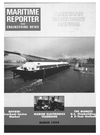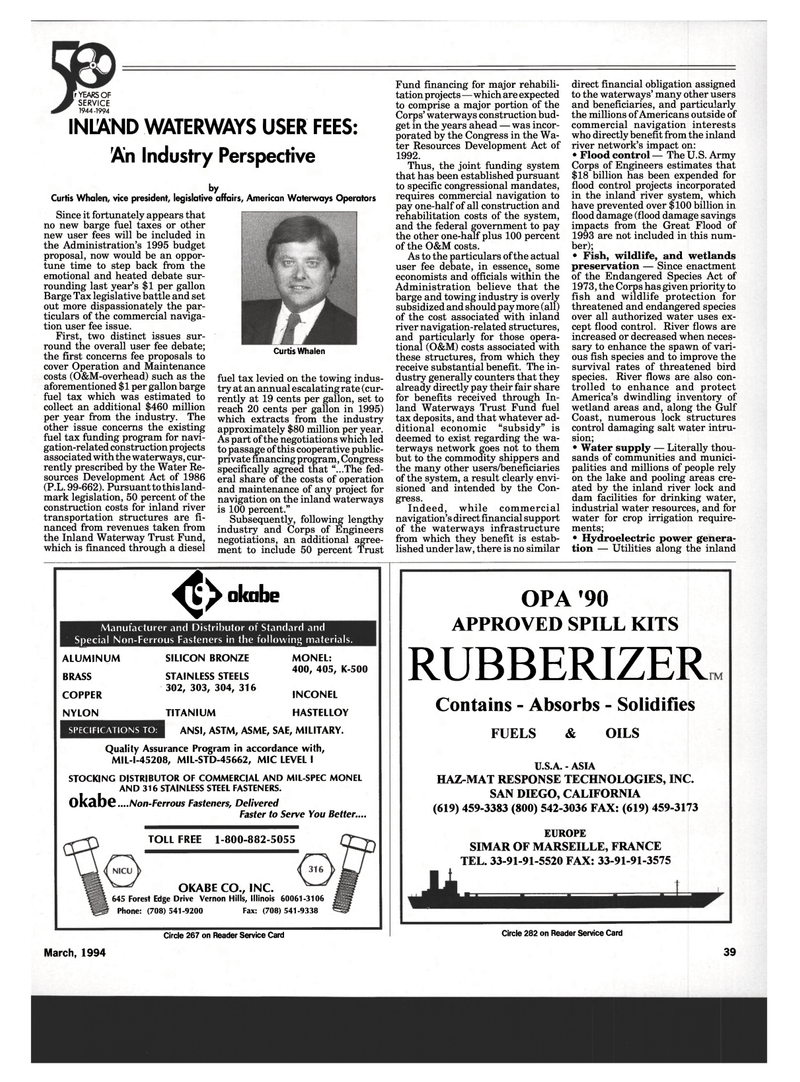
Page 37: of Maritime Reporter Magazine (March 1994)
Read this page in Pdf, Flash or Html5 edition of March 1994 Maritime Reporter Magazine
r YEARS OF SERVICE 1944-1994
INLAND WATERWAYS USER FEES:
An Industry Perspective by
Curtis Whalen, vice president, legislative affairs, American Waterways Operators
Since it fortunately appears that no new barge fuel taxes or other new user fees will be included in the Administration's 1995 budget proposal, now would be an oppor- tune time to step back from the emotional and heated debate sur- rounding last year's $1 per gallon
Barge Tax legislative battle and set out more dispassionately the par- ticulars of the commercial naviga- tion user fee issue.
First, two distinct issues sur- round the overall user fee debate; the first concerns fee proposals to cover Operation and Maintenance costs (O&M-overhead) such as the aforementioned $1 per gallon barge fuel tax which was estimated to collect an additional $460 million per year from the industry. The other issue concerns the existing fuel tax funding program for navi- gation-related construction projects associated with the waterways, cur- rently prescribed by the Water Re- sources Development Act of 1986 (P.L. 99-662). Pursuant to this land- mark legislation, 50 percent of the construction costs for inland river transportation structures are fi- nanced from revenues taken from the Inland Waterway Trust Fund, which is financed through a diesel
Curtis Whalen fuel tax levied on the towing indus- try at an annual escalating rate (cur- rently at 19 cents per gallon, set to reach 20 cents per gallon in 1995) which extracts from the industry approximately $80 million per year.
As part of the negotiations which led to passage of this cooperative public- private financing program, Congress specifically agreed that "...The fed- eral share of the costs of operation and maintenance of any project for navigation on the inland waterways is 100 percent."
Subsequently, following lengthy industry and Corps of Engineers negotiations, an additional agree- ment to include 50 percent Trust
Fund financing for major rehabili- tation projects—which are expected to comprise a major portion of the
Corps' waterways construction bud- get in the years ahead — was incor- porated by the Congress in the Wa- ter Resources Development Act of 1992.
Thus, the joint funding system that has been established pursuant to specific congressional mandates, requires commercial navigation to pay one-half of all construction and rehabilitation costs of the system, and the federal government to pay the other one-half plus 100 percent of the O&M costs.
As to the particulars of the actual user fee debate, in essence, some economists and officials within the
Administration believe that the barge and towing industry is overly subsidized and should pay more (all) of the cost associated with inland river navigation-related structures, and particularly for those opera- tional (O&M) costs associated with these structures, from which they receive substantial benefit. The in- dustry generally counters that they already directly pay their fair share for benefits received through In- land Waterways Trust Fund fuel tax deposits, and that whatever ad- ditional economic "subsidy" is deemed to exist regarding the wa- terways network goes not to them but to the commodity shippers and the many other users/beneficiaries of the system, a result clearly envi- sioned and intended by the Con- gress.
Indeed, while commercial navigation's direct financial support of the waterways infrastructure from which they benefit is estab- lished under law, there is no similar direct financial obligation assigned to the waterways' many other users and beneficiaries, and particularly the millions of Americans outside of commercial navigation interests who directly benefit from the inland river network's impact on: • Flood control — The U.S. Army
Corps of Engineers estimates that $18 billion has been expended for flood control projects incorporated in the inland river system, which have prevented over $100 billion in flood damage (flood damage savings impacts from the Great Flood of 1993 are not included in this num- ber); • Fish, wildlife, and wetlands preservation — Since enactment of the Endangered Species Act of 1973, the Corps has given priority to fish and wildlife protection for threatened and endangered species over all authorized water uses ex- cept flood control. River flows are increased or decreased when neces- sary to enhance the spawn of vari- ous fish species and to improve the survival rates of threatened bird species. River flows are also con- trolled to enhance and protect
America's dwindling inventory of wetland areas and, along the Gulf
Coast, numerous lock structures control damaging salt water intru- sion; • Water supply — Literally thou- sands of communities and munici- palities and millions of people rely on the lake and pooling areas cre- ated by the inland river lock and dam facilities for drinking water, industrial water resources, and for water for crop irrigation require- ments; • Hydroelectric power genera- tion — Utilities along the inland 4> okabe
Manufacturer and Distributor of Standard and
Special Non-Ferrous Fasteners in the following materials.
ALUMINUM
BRASS
COPPER
NYLON
SPECIFICATIONS TO:
SILICON BRONZE
STAINLESS STEELS 302, 303, 304, 316
MONEL: 400, 405, K-500
INCONEL
TITANIUM HASTELLOY
ANSI, ASTM, ASME, SAE, MILITARY.
Quality Assurance Program in accordance with,
MIL-I-45208, MIL-STD-45662, MIC LEVEL I
STOCKING DISTRIBUTOR OF COMMERCIAL AND MIL-SPEC MONEL
AND 316 STAINLESS STEEL FASTENERS. okabe... .Non-Ferrous Fasteners, Delivered
Faster to Serve You Better....
TOLL FREE 1-800-882-5055
OKABE CO., INC. 645 Forest Edge Drive Vernon Hills, Illinois 60061-3106
Phone: (708) 541-9200 Fax: (708) 541-9338
Circle 267 on Reader Service Card
OPA '90
APPROVED SPILL KITS
RUBBERIZER
Contains - Absorbs - Solidifies
FUELS & OILS
U.S.A. - ASIA
HAZ-MAT RESPONSE TECHNOLOGIES, INC.
SAN DIEGO, CALIFORNIA (619) 459-3383 (800) 542-3036 FAX: (619) 459-3173
EUROPE
SIMAR OF MARSEILLE, FRANCE
TEL. 33-91-91-5520 FAX: 33-91-91-3575
Circle 282 on Reader Service Card
March, 1994 39

 36
36

 38
38
